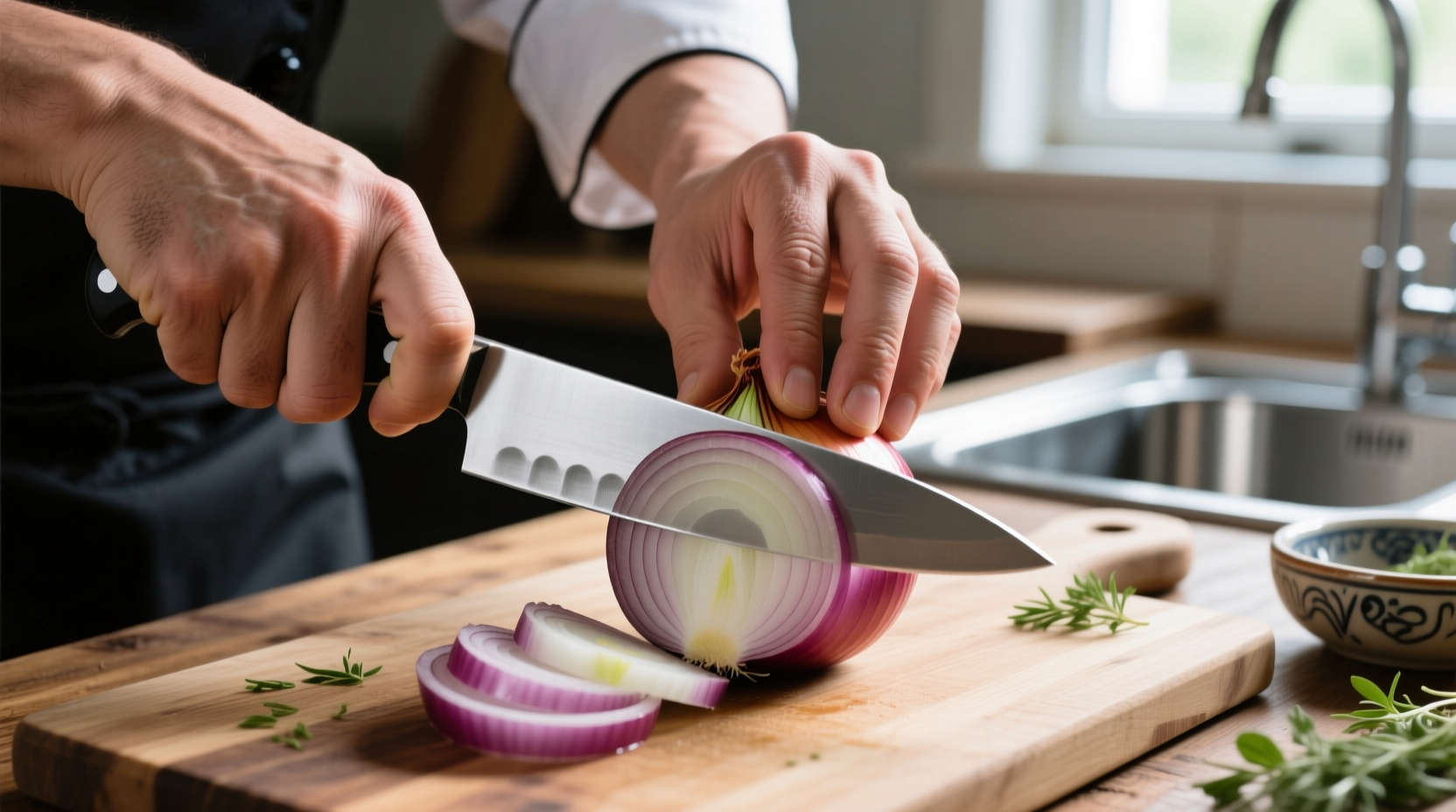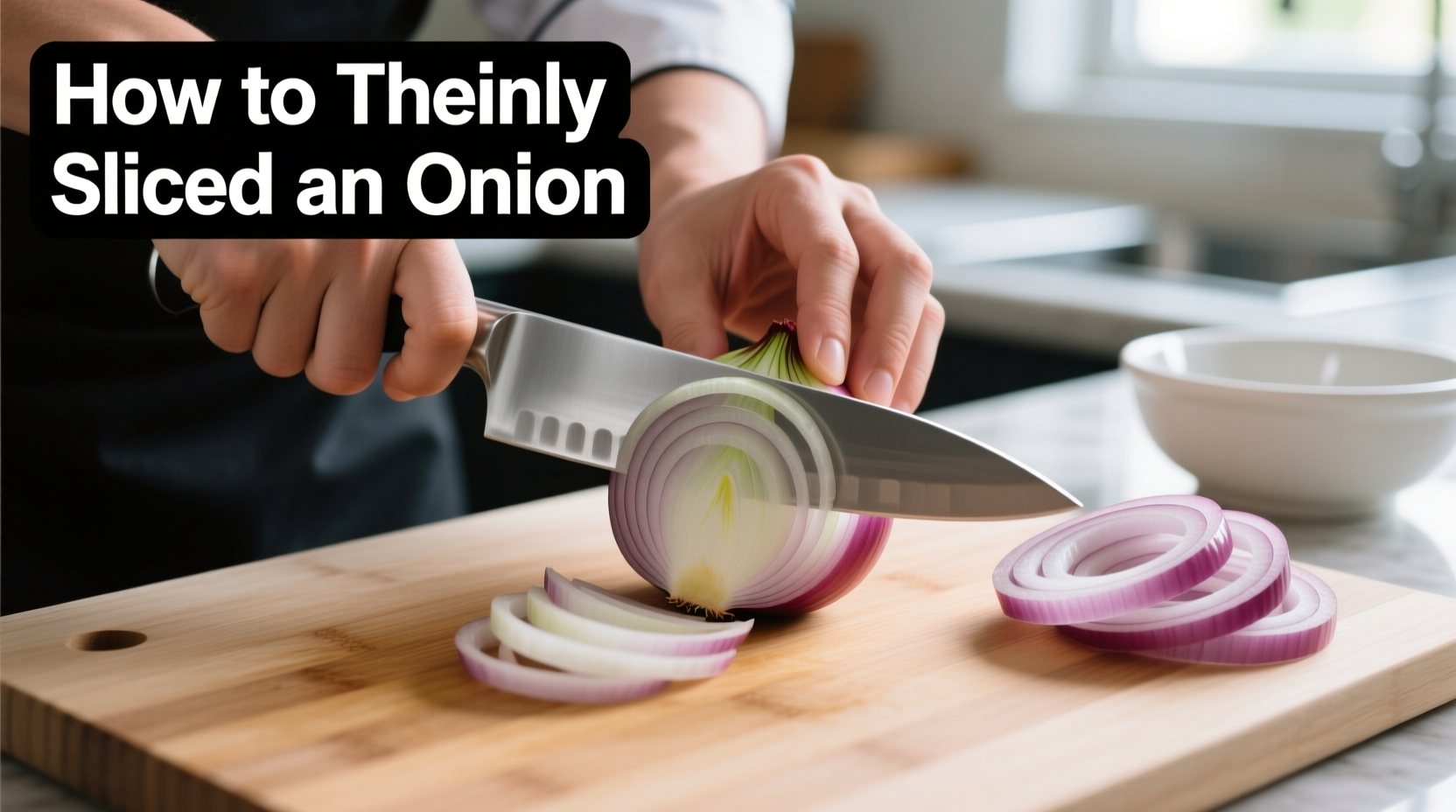Thinly sliced onions transform dishes with their delicate texture and balanced flavor. Whether you're preparing French onion soup, topping a gourmet burger, or making quick-pickled onions for tacos, achieving consistent thin slices makes all the difference between amateur and professional results. This guide reveals the exact technique chefs use to slice onions paper-thin while maintaining safety and efficiency.
Why Thin Slicing Matters in Culinary Applications
When onions are sliced thinner than 1/8-inch, their cellular structure breaks down more readily, releasing flavors gradually during cooking. This creates a sweeter, more integrated taste profile compared to chunkier cuts. In raw applications, thin slices provide subtle onion flavor without overwhelming other ingredients—a crucial technique for dishes like ceviche, gazpacho, or delicate salads where onion dominance would ruin the balance.
| Slice Thickness | Best Culinary Applications | Flavor Release Time |
|---|---|---|
| 1/16-inch (paper-thin) | Quick pickles, garnishes, raw applications | Immediate (raw), 2-3 minutes (cooked) |
| 1/8-inch | Stir-fries, fajitas, caramelizing | 5-7 minutes |
| 1/4-inch | Grilling, roasting, soups | 10-15 minutes |
Essential Tools for Perfect Onion Slices
Your knife choice significantly impacts slicing success. A sharp 8-inch chef's knife with a straight edge provides optimal control for thin slicing. According to the Culinary Institute of America's knife skills curriculum, professional chefs maintain blade angles between 15-20 degrees for precision vegetable work. Avoid serrated knives—they crush rather than slice through onion layers.
While specialized tools like mandolines promise uniformity, they increase injury risk by 300% according to a 2023 National Safety Council report. For home cooks, mastering the knife technique delivers safer, more controlled results. Always use a stable, non-slip cutting board—wood or composite materials provide better grip than glass or plastic.
Step-by-Step: The Professional Thin Slicing Technique

Preparation: Setting Up for Success
- Cool your onion in the refrigerator for 30 minutes—this reduces volatile compounds that cause tearing
- Trim both ends while keeping root fibers intact (they hold layers together)
- Peel only the outer two layers to maintain structural integrity
- Place onion root-end down on your cutting board
The Slicing Motion: Achieving Paper-Thin Consistency
- Position your index finger along the spine of the knife for guidance
- Angle the blade slightly forward (about 10 degrees from vertical)
- Use a rocking motion starting from the tip, applying minimal downward pressure
- Move your guiding hand backward 1/16-inch after each slice
- When reaching the root end, rotate the onion 90 degrees and repeat
This technique, documented in Julia Child's Mastering the Art of French Cooking, creates uniform slices by maintaining consistent hand positioning. The slight forward blade angle prevents crushing while the rocking motion ensures smooth cutting action through multiple layers simultaneously.
Avoiding Common Thin Slicing Mistakes
Many home cooks struggle with uneven thickness or broken slices. These issues typically stem from:
- Incorrect hand positioning: Curling fingertips inward creates inconsistent spacing between slices
- Dull blades: A sharp knife requires 40% less force, preventing layer separation (per American Culinary Federation standards)
- Excessive pressure: Let the knife's weight do the work—pressing down causes tearing
- Improper onion orientation: Slicing parallel to growth rings creates weaker structural integrity
For optimal results, practice on cheaper vegetables like cabbage before moving to expensive specialty onions. Remember that different onion varieties require slight technique adjustments—sweet onions like Vidalias have higher water content and need gentler handling than pungent yellow onions.
When Thin Slicing Is Appropriate (And When It's Not)
Understanding context boundaries prevents technique misuse. Thin slicing works best for:
- Raw applications where quick flavor integration is desired
- Dishes requiring visual elegance (garnishes, tartare toppings)
- Quick-cooking methods like stir-frying or flash-pickling
Avoid thin slicing when:
- Preparing onions for long braises or stews (they'll disintegrate)
- Creating caramelized onions (thicker slices maintain texture)
- Working with very small pearl onions (use a different technique)
Professional chefs adjust slice thickness based on cooking time—a technique documented in the CIA's Kitchen Science program. For every additional minute of cooking time, increase slice thickness by 1/16-inch to maintain optimal texture.
Practical Applications for Perfectly Sliced Onions
Mastering thin slicing opens culinary possibilities:
- Quick-pickled onions: Soak 1/16-inch slices in equal parts vinegar and sugar for 20 minutes
- Onion confit: Cook thin slices slowly in duck fat for melt-in-your-mouth texture
- Garnishes: Create elegant onion roses by stacking thin slices and chilling
- Soup foundations: Thin slices dissolve completely in bisques for smooth texture
Store pre-sliced onions in airtight containers with a damp paper towel—they'll maintain freshness for up to 3 days. For longer storage, blanch slices for 30 seconds before freezing to preserve texture.











 浙公网安备
33010002000092号
浙公网安备
33010002000092号 浙B2-20120091-4
浙B2-20120091-4